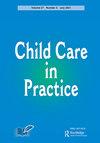Implementing Aistear – the Early Childhood Curriculum Framework Across Varied Settings: Experiences of Early Years Educators and Infant Primary School Teachers in the Irish Context
IF 1.4
Q3 FAMILY STUDIES
引用次数: 2
Abstract
ABSTRACT Aistear: The Early Childhood Curriculum Framework, was launched in Ireland in 2009. The framework is applicable in all settings where children in the 0-6-year range are present; this includes all early years settings and the first two years of primary schools, referred to as “infant classes” in the Irish context. This article shares the findings of a local research project which sought to explore the implementation of “Aistear”, by Early Years Educators (EYEs) and Primary School Teachers (PSTs) in pre-schools and infant classes. This research, based on a qualitative case-study design, was primarily focused on those educators working with children who are between three and six years of age and was based in the North East region of Ireland. The study examined the implementation of Aistear and how educators adapted their existing curriculum and daily routine. Thirteen educators participated, including six EYEs and seven PSTs. The collected data was thematically analysed with the emerging story captured through five key themes: Emergent Curriculum, Social Development, Communication, Holistic Development, and Implementation of Aistear. Overall, the benefits for children’s social interactions, language development and cognitive development through play in a child-led environment were discussed by participants. However, training, ratios and resources were a concern and a requirement for EYEs and PSTs. The recommendations from this study indicates that further research into the implementation of Aistear on a national scale would offer greater insight into the adaptation of the curriculum framework within pre-schools and infant classes in primary schools.在不同环境中实施Aisrear——幼儿课程框架:爱尔兰背景下幼儿教育工作者和幼儿小学教师的经验
摘要Aistrear:《幼儿课程框架》于2009年在爱尔兰推出。该框架适用于0-6岁儿童所在的所有环境;这包括所有的早期环境和小学的前两年,在爱尔兰被称为“婴儿班”。本文分享了当地一个研究项目的发现,该项目旨在探索幼儿教育工作者(EYEs)和小学教师(PSTs)在学前教育和婴儿班中实施“Aistear”的情况。这项研究基于定性案例研究设计,主要针对爱尔兰东北地区从事3至6岁儿童教育的教育工作者。这项研究考察了Aistear的实施情况,以及教育工作者如何调整现有的课程和日常生活。13名教育工作者参加了培训,其中包括6名EYE和7名PST。对收集到的数据进行了主题分析,并通过五个关键主题捕捉到了新出现的故事:紧急课程、社会发展、沟通、整体发展和Aistear的实施。总体而言,参与者讨论了在儿童主导的环境中玩耍对儿童社交、语言发展和认知发展的好处。然而,培训、比率和资源是一个令人担忧的问题,也是对EYE和PST的要求。这项研究的建议表明,在全国范围内对Aistear的实施进行进一步研究,将有助于更好地了解学前教育和小学幼儿班课程框架的适应情况。
本文章由计算机程序翻译,如有差异,请以英文原文为准。
求助全文
约1分钟内获得全文
求助全文
来源期刊

Child Care in Practice
Nursing-Community and Home Care
CiteScore
3.30
自引率
5.30%
发文量
32
期刊介绍:
Child Care in Practice is a quarterly, peer-reviewed journal that provides an international forum for professionals working in all disciplines in the provision of children’s services, including social work, social care, health care, medicine, psychology, education, the police and probationary services, and solicitors and barristers working in the family law and youth justice sectors. The strategic aims and objectives of the journal are: • To develop the knowledge base of practitioners, managers and other professionals responsible for the delivery of professional child care services. The journal seeks to contribute to the achievement of quality services and the promotion of the highest standards. • To achieve an equity of input from all disciplines working with children. The multi-disciplinary nature of the journal reflects that the key to many successful outcomes in the child care field lies in the close co-operation between different disciplines. • To raise awareness of often-neglected issues such as marginalization of ethnic minorities and problems consequent upon poverty and disability. • To keep abreast of and continue to influence local and international child care practice in response to emerging policy. • To include the views of those who are in receipt of multi-disciplinary child care services. • To welcome submissions on promising practice developments and the findings from new research to highlight the breadth of the work of the journal’s work.
 求助内容:
求助内容: 应助结果提醒方式:
应助结果提醒方式:


